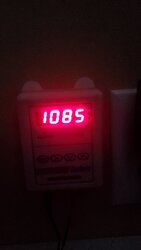Thank you all again for your thoughts and suggestions. You guys are great! It is really appreciated as we‘re trying to get a handle on all this after running a stove which came with our house and with some issues. It was in pretty sad shape and I’ve been trying to get it up to speed a bit at a time. New gaskets, new glass and, as I explained above, replacing a non working cat and secondary air probe. As suggested, I will get and install (with your help) a cat probe. A couple of additional questions for now and comments please on something that happened yesterday that is of concern.
We had the chimney and flue swept by a professional about a month ago and I THINK that in spite of that we had a small (?) fire in the flue/chimney just yesterday. All seemed well with how the stove was performing as described above. I did my usual morning ash clean up and reloading and went out to do some snow blowing (brutal up here in Andes, NY). I happened to look toward the house and noticed an unusual amount of gray/white smoke coming out the chimney. My wife, who was inside the house called me and said that the griddle temp was reading 450, but the flue temp had risen to 900(!). We never let that temp rise above 500 or so. She closed the air control completely, the temp started to fall and settled to normal. My concern is, per Randy’s comments, that I damaged the cat. Is it possible for the flue temp to rise so high while the griddle temp remains that much lower? After temps settled down, we did recommend test of the cat (per the manual) by opening and closing the damper and observing the amount of smoke leaving the chimney. Here’s the weird thing:
The first three times that we opened and closed the damper there was much MORE smoke with the damper closed than with it open; the opposite of what should happen. Afterwards things returned to normal; much less or no smoke with damper closed and more smoke with it open. Is it possible the cat was burning up ash that had fallen in during the possible flue fire. Or, was the smoke from the cat itself? This morning all seems normal. We did the smoke test again and things appeared to be normal; more smoke with damper open.
; less or none with damper closed. Temps are as described in my original post. Obvious concern: could I have damaged the cat either with too high a temp or with ash?
Lastly (for now ☺). Still a source of some confusion is that the Condar flue probe therm reads that 400-900 is the “Normal” range. Yet, my Imperial griddle top therm reads that 500 and higher is in the “Overfire” range. If I get flue temps up to 600 I am well into the “Overfire” range and, as Randy states, in danger of damaging the cat. Or, are the two temperatures more ”independent“ of each other than I thought? If the griddle temp is at 450, which is the temp the manual recommends to fire the cat, what would cause the cat’s temp to rise so much; assuming that was what happened? What am I missing?
BTW, Re Randy’s question: Yes, I can maintain a little bit, not much, flame in the box with damper closed.
Thank you all again for the help and patience. Huge help!
 www.hearth.com
www.hearth.com
 www.hearth.com
www.hearth.com


